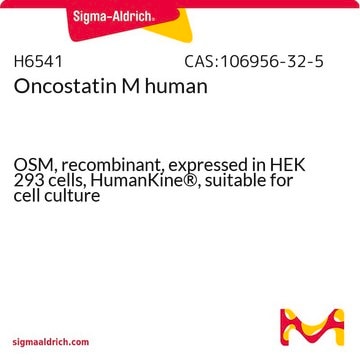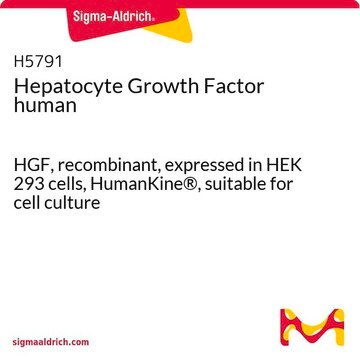O1637
Oncostatin M from mouse
BioReagent, ≥97% (SDS-PAGE), recombinant, expressed in E. coli, lyophilized powder, suitable for cell culture
Synonym(s):
OSM
Sign Into View Organizational & Contract Pricing
All Photos(1)
About This Item
Recommended Products
biological source
mouse
Quality Level
recombinant
expressed in E. coli
product line
BioReagent
Assay
≥97% (SDS-PAGE)
form
lyophilized powder
potency
0.25-1 ng/mL EC50
mol wt
21 kDa
packaging
pkg of 25 μg
technique(s)
cell culture | mammalian: suitable
impurities
endotoxin, tested
UniProt accession no.
storage temp.
−20°C
Gene Information
mouse ... Osm(18413)
Application
Oncostatin M from mouse has been used in the preparation of culture medium for primary culture of mouse fetal hepatoblasts (MFHs).
Biochem/physiol Actions
Oncostatin M, LIF, G-CSF, IL-6, and ciliary neurotrophic factor (CNTF) are structurally related members of the same cytokine family sharing similarities in their primary amino acid sequences, predicted secondary structure, and receptor components. Oncostatin M is a growth-regulating cytokine, affecting a number of tumor and normal cells. This material was first identified by its ability to inhibit the growth of A375 melanoma cells and other human tumor cells, but not inhibit the growth of normal human fibroblasts. It acts synergistically with TGF β1 to inhibit the proliferation of tumor cells like A375 melanoma cells. It induces an increase in LDL receptor expression and LDL uptake by hepatoma cells. OSM activates synovial fibroblast-like cells to produce urokinase type plasminogen activator. Oncostatin M is secreted by macrophages and activated T lymphocytes.
Physical form
Lyophilized from a 0.2 μm filtered solution in phosphate buffered saline containing 1.25 mg bovine serum albumin.
Analysis Note
The biological activity of recombinant mouse OSM was measured by its ability to stimulate 3H-thymidine incorporation in quiescent NIH/3T3 cells.
Storage Class Code
11 - Combustible Solids
WGK
WGK 3
Flash Point(F)
Not applicable
Flash Point(C)
Not applicable
Personal Protective Equipment
dust mask type N95 (US), Eyeshields, Gloves
Certificates of Analysis (COA)
Search for Certificates of Analysis (COA) by entering the products Lot/Batch Number. Lot and Batch Numbers can be found on a product’s label following the words ‘Lot’ or ‘Batch’.
Already Own This Product?
Find documentation for the products that you have recently purchased in the Document Library.
Tadasuke Komori et al.
Diabetologia, 58(8), 1868-1876 (2015-05-15)
Obesity and insulin resistance are closely associated with adipose tissue dysfunction caused by the abnormal recruitment of inflammatory cells, including macrophages. Oncostatin M (OSM), a member of the IL-6 family of cytokines, plays important roles in a variety of biological
Yu-Fan Chen et al.
Hepatology (Baltimore, Md.), 55(4), 1193-1203 (2011-11-19)
Liver transplantation is the only definitive treatment for end-stage cirrhosis and fulminant liver failure, but the lack of available donor livers is a major obstacle to liver transplantation. Recently, induced pluripotent stem cells (iPSCs) derived from the reprogramming of somatic
Yuxin Wang et al.
Proceedings of the National Academy of Sciences of the United States of America, 110(42), 16975-16980 (2013-10-02)
The activation of STAT3 by tyrosine phosphorylation, essential for normal development and for a normal inflammatory response to invading pathogens, is kept in check by negative regulators. Abnormal constitutive activation of STAT3, which contributes to the pathology of cancer and
Luc Gailhouste
Methods in molecular biology (Clifton, N.J.), 826, 33-47 (2011-12-15)
During development, liver precursors constitute a valuable source of pluripotent stem cells that present the ability to differentiate into both a hepatic and biliary lineage. In the present chapter, we report an experimental procedure developed by our group to isolate
Nathan R West et al.
Endocrine-related cancer, 19(2), 181-195 (2012-01-24)
The most important clinical biomarker for breast cancer management is oestrogen receptor alpha (ERα). Tumours that express ER are candidates for endocrine therapy and are biologically less aggressive, while ER-negative tumours are largely treated with conventional chemotherapy and have a
Our team of scientists has experience in all areas of research including Life Science, Material Science, Chemical Synthesis, Chromatography, Analytical and many others.
Contact Technical Service







